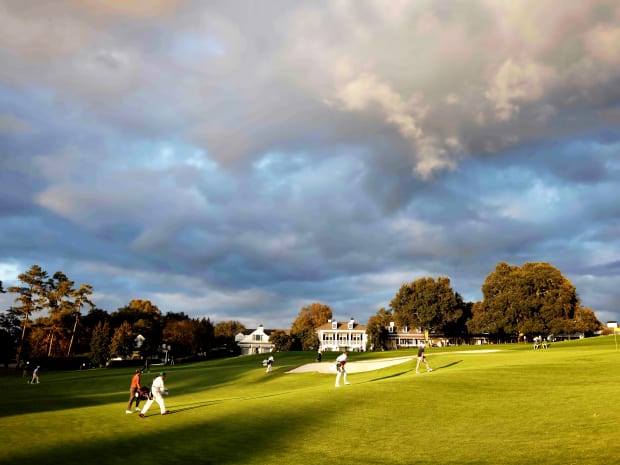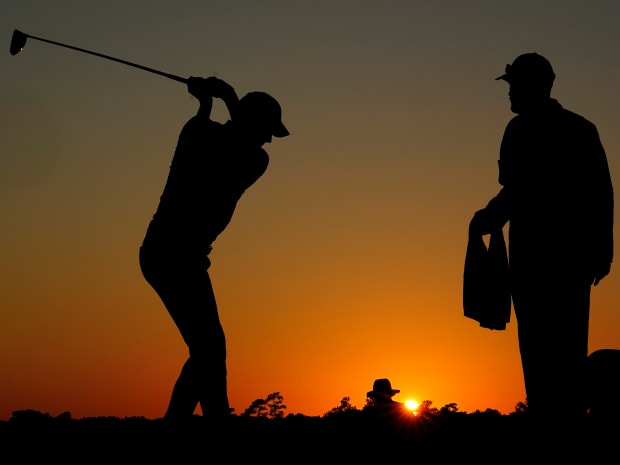Augusta National Golf Club fancies itself as a remove from the world. But this year, the world has intruded.
AUGUSTA, Ga. — As Tiger Woods strode up the 18th fairway on Thursday at three under par, a sound reverberated from the green. But this was not the roar Woods would normally hear at this place under those circumstances. It was the ring of a cell phone.
In a typical year, the offender might have been executed, or worse. Electronic devices, masters.com reminds fans, “are strictly prohibited on the grounds at all times.” (The website clarifies that this includes “phones, laptops, tablets and beepers.”) This year, the gentleman simply fumbled around and silenced the call. No one dragged him from the course. No one revoked his credentials. No one said anything at all.
Augusta National Golf Club fancies itself as a remove from the world. But this year, the world has intruded. The COVID-19 pandemic has forced the tournament committee to move the Masters to November and to hold the event without fans.

Instead of the estimated 40,000 spectators who roam the course each day during a typical year, galleries consist of just a few dozen: club members and their spouses, staff, media and players’ guests. As the best players in the world beat the course into submission, members stand behind tee boxes and debate which club they would use there. At times, the whole thing feels a bit like a rich guy has hired the Eagles to play his retirement party.
Members generally wear their green jackets around the course, in part to distinguish themselves from the riff-raff. This year, there is no riff-raff, other than the couple dozen reporters. Instead of green jackets, most members wear green masks.
Without the fans, there is no need for ropes. There is no need for the concession stands, which famously sell food at prices that seemed cheap even when people wore beepers: Sandwiches top out at $3, beer at $5. Instead, a few kiosks remain open and dispense food for free. The rules—in addition to no cell phones, there is also no running and no thinking about using a cell phone or running—are lightly enforced. Unobtrusive Masters-green hand sanitizing stations dot the course. The pro shop is fully stocked but vacant. There are no lines at the bathrooms. There is no one to try to ascertain, without aid of Google Images, whether that is really Peyton Manning. (It is; he’s a member, as are NFL commissioner Roger Goodell and MLB commissioner Rob Manfred. There is no one to boo them, either.)
Staffers lament how long the days feel without fan interactions. They do not get to watch anyone experience Amen Corner for the first time. They do not get to make faces at kids riding on their parents’ shoulders. They do not get to argue about whether that roar means someone made birdie on No. 6 or No. 16.
The hush of the grounds is probably the strangest part. In an attempt to bring the fans at home closer to the action, the Masters has debuted a few drones that fly over the course capturing video. Woods, warming up for his Thursday round on the putting green, realized that the whirring drowned out the introduction of Gary Player as ceremonial starter just a few yards away. Woods laughed, relating the story. “You don't hear drones here,” he said.
VRENTAS: What Golf's Race Problem Looks Like From the Inside
This year, without the low buzz of fans rustling, you do hear just about every stray word. Players’ profanities after bad shots echo across the course. Photographers are required to use silent mirrorless cameras, because the shutter click would otherwise carry too far. A pinecone drops and everyone nearby spins around, thinking it’s a ball. The grounds also lack the visual equivalent of a low buzz: An unmoving wall of people forms a solid backdrop, but one or two onlookers stand out, so golfers and their caddies regularly ask people to move out of their line of vision.
The course itself is playing differently, too. The autumn weather has brought north wind and wet, soft grass. April in Augusta offers some 13 hours of daylight; in November, it’s 10 1/2. Players have been pulled off the course without completing their rounds on both Thursday and Friday because the sun has set.

When they are out there, they sometimes adjust their shots. “If you do hit it off line, like, say, for example, the second hole, I missed it right there yesterday, and usually where I would have hit that would have been in the patron area, but because it's so wet they usually put this green, sandy stuff down, and we're not really getting any of that,” said Rory McIlroy. ”It makes some shots less intimidating. The second shot into [No.] 2, there's all these people around the green, you're trying to hit it into this little area and feel like you've just got a bit more of an expansive area to hit into when there's no patrons here.”
Bryson DeChambeau paid a price for the lack of spectators: When he pulled his tee shot on No. 3 Friday, the usual throng of fans was not there to point him toward where it landed. He lost his ball and had to re-tee.
Players are allowed to have two people with them: one professional, one personal. Many of the shorter spouses are delighting in the sightlines. Phil Mickelson said his wife, Amy, had never seen him play at Nos. 12 or 13 before this week.
The Mickelsons are able to check in with one another throughout his round. It’s “an experience of a lifetime for both of us,” Phil said.
When Woods won here last year, he rushed off the 18th green and into the arms of his children, daughter Sam and son Charlie, and his mother, Tida. If he wins again this year, they will have to celebrate from afar. Or maybe, if the rules remain this relaxed, someone can FaceTime them in.